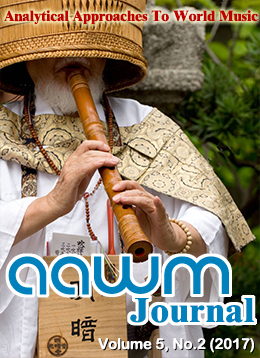 |
| |
 |
 |
|
 |
 |
|
AAWM JOURNAL Volume 5, No. 2 (2017) |
 |
 |
| Volume 5, No.2 (2017) |
| |
 |
 |
| Shakuhachi honkyoku: Motivic analysis of Sokaku Reibo |
| Amy D. Simon (University of Prince Edward Island) |
| Previous studies of shakuhachi honkyoku have approached analysis from the starting point of octave-species scales as well as trichords spanning a perfect fourth. However, a case study of the Kinko-ryū piece Sokaku Reibo shows that not all tonal content is accounted for by these frameworks. Three transpositions of the miyakobushi trichord (m2+M3=P4) account for a portion of what is heard in the piece, but do not give a full picture.
A bottom-up approach based on melodic and rhythmic motives is favored in this study since intervals other than the m2, M3, and P4 of the miyakobushi trichord occur frequently, as do tones that do not fit the usual trichord transpositions. Pitch cells and rhythm cells are repeated, contracted and expanded throughout the 12 dan (sections) of Sokaku Reibo. Analysis of these cells as motives, in addition to analysis of frequently occurring intervals and exceptional tones, is relevant to the overall structure of the piece... more >> |
| |
 |
 |
| Comparisons of African and Diasporic Rhythm: The Ewe, Cuba, and Martinique |
| Julian Gerstin |
| Comparisons of African and Diasporic rhythms by both scholars and working musicians have in recent years increased in sophistication and explanatory power. Yet what Polak (2010) calls the ¡°mainstream¡± view leans heavily on a relatively small number of specific musical cultures, among which Ewe music of Ghana and Afrocuban music are strikingly visible. Should Ewe/Cuban rhythmic structures be taken as paradigmatic of African/Diasporic music? This article briefly reviews current analytical approaches, summarizing the mainstream view, questioning in particular its existing emphasis on formal structures in timelines, and extending it to include dance and the ensemble orchestration of rhythmic roles. The article then presents an analysis of rhythmic structures in music and dance of Martinique, demonstrating that some aspects of Ewe and Cuban rhythm do not apply in other African/Diasporic cases. Specifically, Martinican music is not oriented (that is, structured by a contrast between 3-3-2 and non-3-3-2 rhythms); embedded 3-3-2 figures clash with rather than reinforce one another; and ternary music is based on three main beats rather than the typical Ewe/Cuban four main beats, excepting one highly ambiguous dance that cannot be reduced to either. The article argues for a broader, more flexible picture of African/Diasporic rhythmic structure.... more >> |
| |
 |
 |
| Principles of Transmission and Collective Composition in Turkmen Dutar Performance |
| David Fossum (University of Pittsburgh) |
| This paper focuses on a repertoire of instrumental pieces performed and orally transmitted among players of a two-stringed lute called dutar in Turkmenistan. Through music analysis, it seeks to illustrate exactly how Turkmen dutar players negotiate contrasting demands to maintain the pieces as learned from their masters while also developing them over time as part of an ongoing collective composition process. The analysis relates to a complexly interconnected set of research areas: studies of that focus on the importance of formulas and patterns to the process of reconstructing memorized material and studies that show how musicians draw on formulas, internalized schemas, and compositional principles to generate new musical material in the course of improvisation or composition. While Turkmen music does not feature separate, marked spaces for generating new melodic sequences at length as do most of the genres that have been studied by scholars taking similar analytical approaches, we can observe similar generative processes at play in the ways that Turkmen musicians vary and expand on traditional repertoire. Specifically, I show how traditional pieces feature constantly shifting constraints on and affordances for variation and development. Turkmen musicians internalize principles for exploiting such affordances in the process of learning the repertoire and reapply these to the traditional compositions as they reconstruct them in performance. I separate such analytical observations from the question of how Turkmens assess and valorize performers¡¯ variations on and contributions to the traditional compositions, providing additional ethnographic data on this point. In doing so, I also seek to bring clarity to some of the confusion surrounding the much-discussed, problematic term ¡°improvisation.¡± .... more >> |
|
|
 |
|
 |
 |
|



